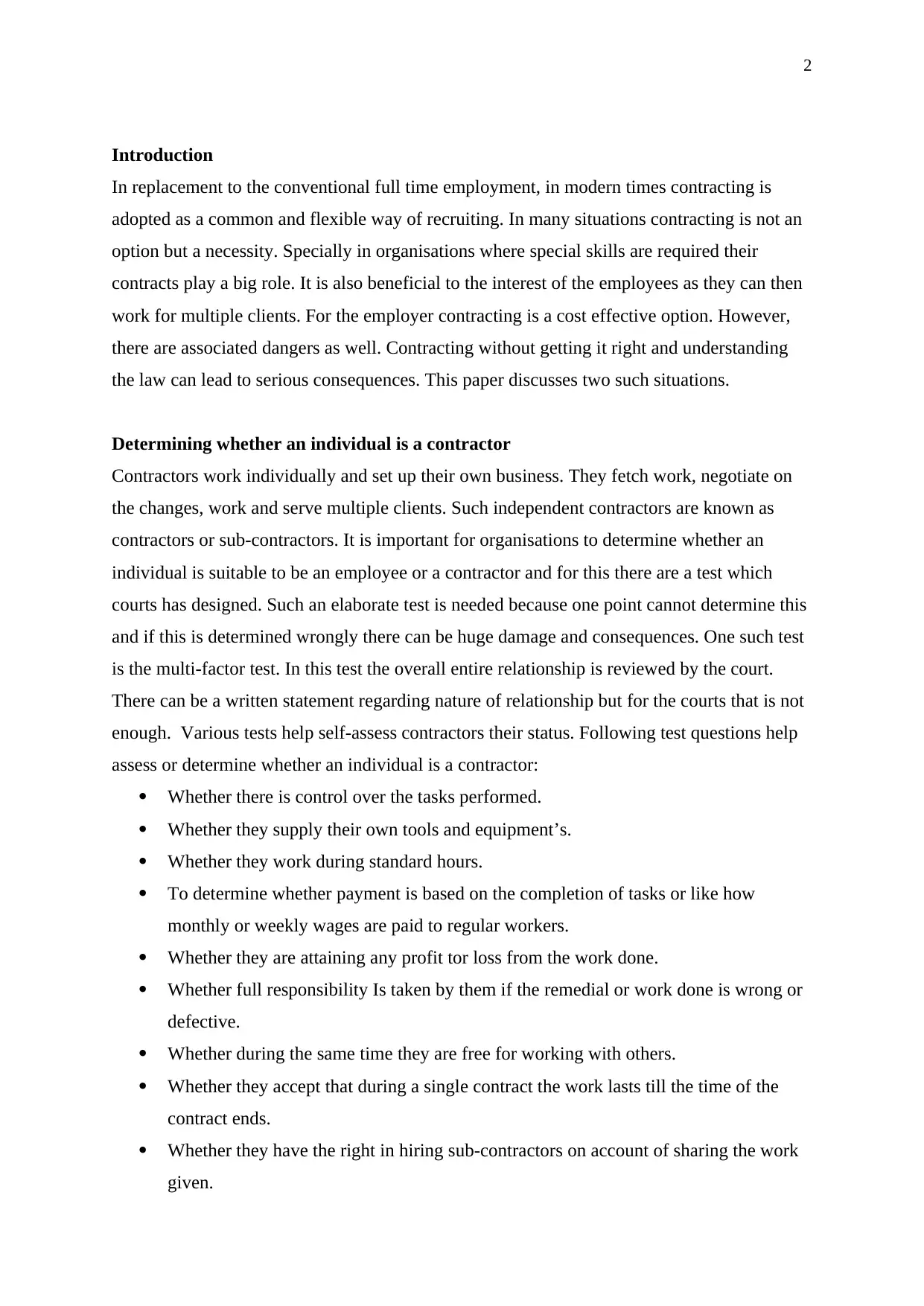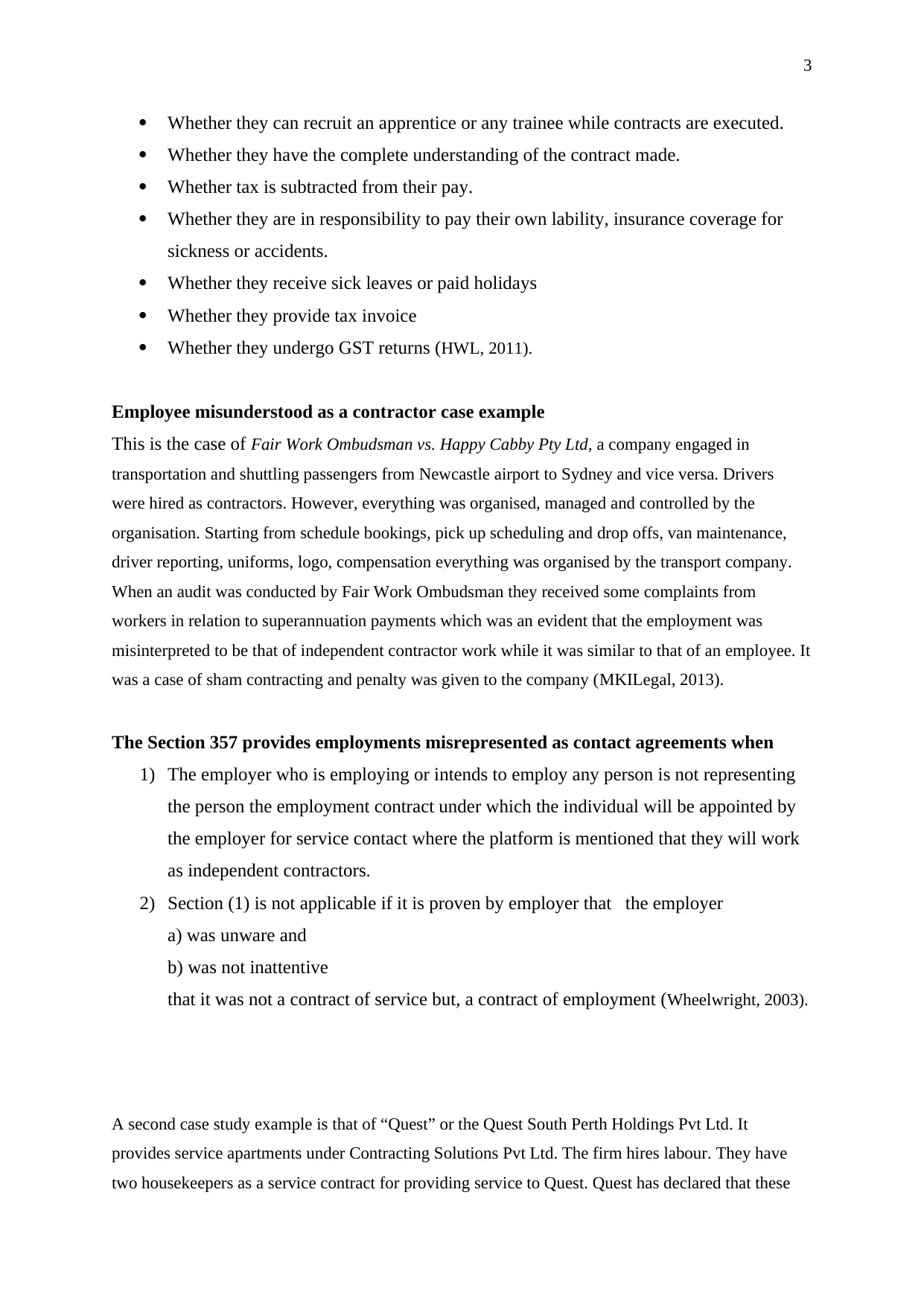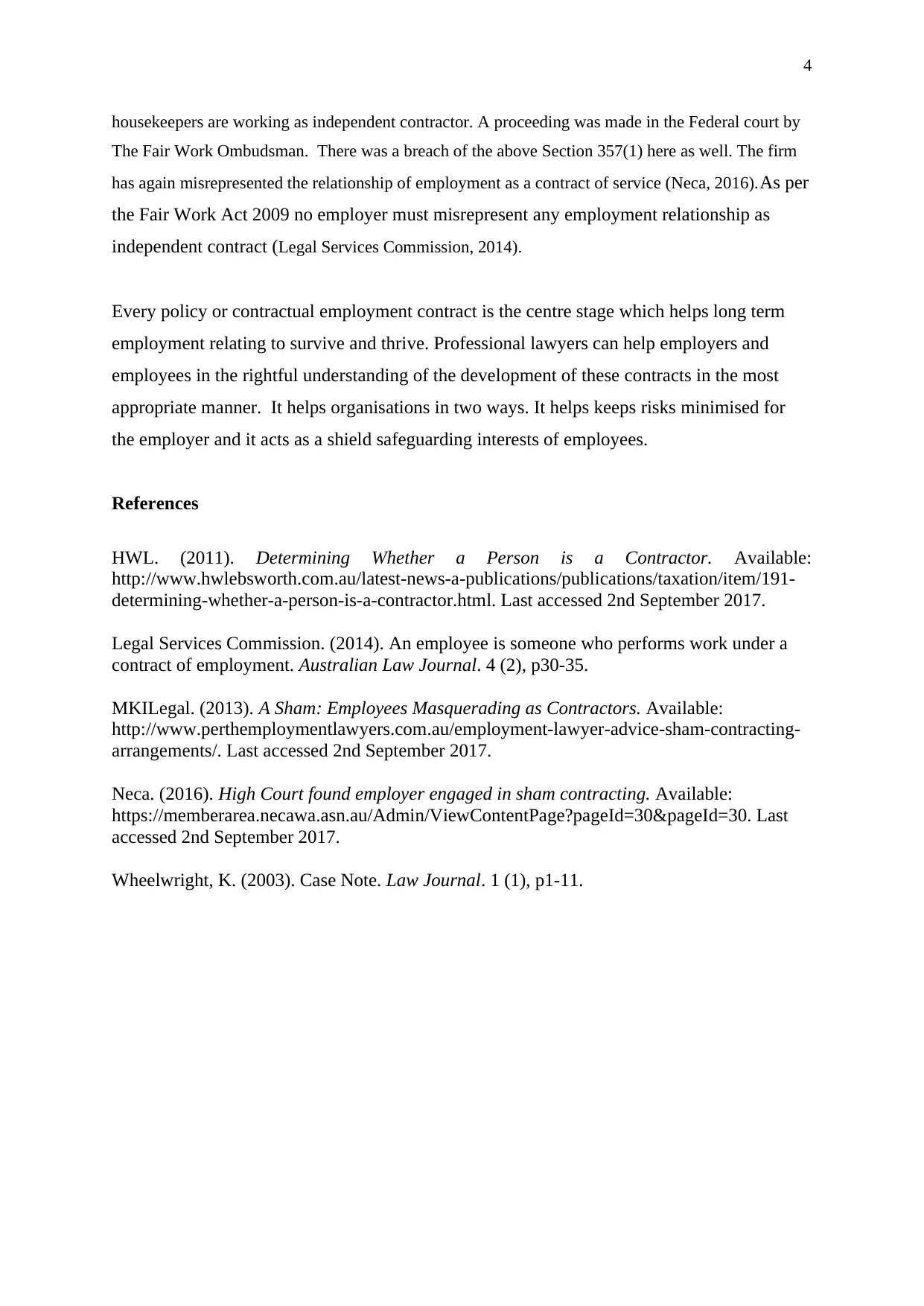Employment Law: Contractor vs. Employee in the Workplace Report
VerifiedAdded on 2020/02/19
|4
|1083
|134
Report
AI Summary
This report examines the legal distinctions between contractors and employees in the context of employment law, highlighting the importance of accurate classification. It discusses the prevalence of contracting, the benefits it offers, and the associated risks of misclassification, which can lead to serious legal consequences. The report introduces the multi-factor test used by courts to determine the nature of the employment relationship, emphasizing that no single factor is decisive. It presents a series of questions to assess whether an individual is a contractor and provides case studies, including Fair Work Ombudsman vs. Happy Cabby Pty Ltd and Quest South Perth Holdings Pvt Ltd, to illustrate instances of sham contracting and the application of relevant legislation, such as Section 357 of the Fair Work Act 2009. The report concludes by emphasizing the role of professional legal advice in navigating the complexities of employment contracts to minimize risks for employers and protect the interests of employees.

1
Employment Law
Student Name
Student Id
Employment Law
Student Name
Student Id
Paraphrase This Document
Need a fresh take? Get an instant paraphrase of this document with our AI Paraphraser

2
Introduction
In replacement to the conventional full time employment, in modern times contracting is
adopted as a common and flexible way of recruiting. In many situations contracting is not an
option but a necessity. Specially in organisations where special skills are required their
contracts play a big role. It is also beneficial to the interest of the employees as they can then
work for multiple clients. For the employer contracting is a cost effective option. However,
there are associated dangers as well. Contracting without getting it right and understanding
the law can lead to serious consequences. This paper discusses two such situations.
Determining whether an individual is a contractor
Contractors work individually and set up their own business. They fetch work, negotiate on
the changes, work and serve multiple clients. Such independent contractors are known as
contractors or sub-contractors. It is important for organisations to determine whether an
individual is suitable to be an employee or a contractor and for this there are a test which
courts has designed. Such an elaborate test is needed because one point cannot determine this
and if this is determined wrongly there can be huge damage and consequences. One such test
is the multi-factor test. In this test the overall entire relationship is reviewed by the court.
There can be a written statement regarding nature of relationship but for the courts that is not
enough. Various tests help self-assess contractors their status. Following test questions help
assess or determine whether an individual is a contractor:
Whether there is control over the tasks performed.
Whether they supply their own tools and equipment’s.
Whether they work during standard hours.
To determine whether payment is based on the completion of tasks or like how
monthly or weekly wages are paid to regular workers.
Whether they are attaining any profit tor loss from the work done.
Whether full responsibility Is taken by them if the remedial or work done is wrong or
defective.
Whether during the same time they are free for working with others.
Whether they accept that during a single contract the work lasts till the time of the
contract ends.
Whether they have the right in hiring sub-contractors on account of sharing the work
given.
Introduction
In replacement to the conventional full time employment, in modern times contracting is
adopted as a common and flexible way of recruiting. In many situations contracting is not an
option but a necessity. Specially in organisations where special skills are required their
contracts play a big role. It is also beneficial to the interest of the employees as they can then
work for multiple clients. For the employer contracting is a cost effective option. However,
there are associated dangers as well. Contracting without getting it right and understanding
the law can lead to serious consequences. This paper discusses two such situations.
Determining whether an individual is a contractor
Contractors work individually and set up their own business. They fetch work, negotiate on
the changes, work and serve multiple clients. Such independent contractors are known as
contractors or sub-contractors. It is important for organisations to determine whether an
individual is suitable to be an employee or a contractor and for this there are a test which
courts has designed. Such an elaborate test is needed because one point cannot determine this
and if this is determined wrongly there can be huge damage and consequences. One such test
is the multi-factor test. In this test the overall entire relationship is reviewed by the court.
There can be a written statement regarding nature of relationship but for the courts that is not
enough. Various tests help self-assess contractors their status. Following test questions help
assess or determine whether an individual is a contractor:
Whether there is control over the tasks performed.
Whether they supply their own tools and equipment’s.
Whether they work during standard hours.
To determine whether payment is based on the completion of tasks or like how
monthly or weekly wages are paid to regular workers.
Whether they are attaining any profit tor loss from the work done.
Whether full responsibility Is taken by them if the remedial or work done is wrong or
defective.
Whether during the same time they are free for working with others.
Whether they accept that during a single contract the work lasts till the time of the
contract ends.
Whether they have the right in hiring sub-contractors on account of sharing the work
given.

3
Whether they can recruit an apprentice or any trainee while contracts are executed.
Whether they have the complete understanding of the contract made.
Whether tax is subtracted from their pay.
Whether they are in responsibility to pay their own lability, insurance coverage for
sickness or accidents.
Whether they receive sick leaves or paid holidays
Whether they provide tax invoice
Whether they undergo GST returns (HWL, 2011).
Employee misunderstood as a contractor case example
This is the case of Fair Work Ombudsman vs. Happy Cabby Pty Ltd, a company engaged in
transportation and shuttling passengers from Newcastle airport to Sydney and vice versa. Drivers
were hired as contractors. However, everything was organised, managed and controlled by the
organisation. Starting from schedule bookings, pick up scheduling and drop offs, van maintenance,
driver reporting, uniforms, logo, compensation everything was organised by the transport company.
When an audit was conducted by Fair Work Ombudsman they received some complaints from
workers in relation to superannuation payments which was an evident that the employment was
misinterpreted to be that of independent contractor work while it was similar to that of an employee. It
was a case of sham contracting and penalty was given to the company (MKILegal, 2013).
The Section 357 provides employments misrepresented as contact agreements when
1) The employer who is employing or intends to employ any person is not representing
the person the employment contract under which the individual will be appointed by
the employer for service contact where the platform is mentioned that they will work
as independent contractors.
2) Section (1) is not applicable if it is proven by employer that the employer
a) was unware and
b) was not inattentive
that it was not a contract of service but, a contract of employment (Wheelwright, 2003).
A second case study example is that of “Quest” or the Quest South Perth Holdings Pvt Ltd. It
provides service apartments under Contracting Solutions Pvt Ltd. The firm hires labour. They have
two housekeepers as a service contract for providing service to Quest. Quest has declared that these
Whether they can recruit an apprentice or any trainee while contracts are executed.
Whether they have the complete understanding of the contract made.
Whether tax is subtracted from their pay.
Whether they are in responsibility to pay their own lability, insurance coverage for
sickness or accidents.
Whether they receive sick leaves or paid holidays
Whether they provide tax invoice
Whether they undergo GST returns (HWL, 2011).
Employee misunderstood as a contractor case example
This is the case of Fair Work Ombudsman vs. Happy Cabby Pty Ltd, a company engaged in
transportation and shuttling passengers from Newcastle airport to Sydney and vice versa. Drivers
were hired as contractors. However, everything was organised, managed and controlled by the
organisation. Starting from schedule bookings, pick up scheduling and drop offs, van maintenance,
driver reporting, uniforms, logo, compensation everything was organised by the transport company.
When an audit was conducted by Fair Work Ombudsman they received some complaints from
workers in relation to superannuation payments which was an evident that the employment was
misinterpreted to be that of independent contractor work while it was similar to that of an employee. It
was a case of sham contracting and penalty was given to the company (MKILegal, 2013).
The Section 357 provides employments misrepresented as contact agreements when
1) The employer who is employing or intends to employ any person is not representing
the person the employment contract under which the individual will be appointed by
the employer for service contact where the platform is mentioned that they will work
as independent contractors.
2) Section (1) is not applicable if it is proven by employer that the employer
a) was unware and
b) was not inattentive
that it was not a contract of service but, a contract of employment (Wheelwright, 2003).
A second case study example is that of “Quest” or the Quest South Perth Holdings Pvt Ltd. It
provides service apartments under Contracting Solutions Pvt Ltd. The firm hires labour. They have
two housekeepers as a service contract for providing service to Quest. Quest has declared that these
⊘ This is a preview!⊘
Do you want full access?
Subscribe today to unlock all pages.

Trusted by 1+ million students worldwide

4
housekeepers are working as independent contractor. A proceeding was made in the Federal court by
The Fair Work Ombudsman. There was a breach of the above Section 357(1) here as well. The firm
has again misrepresented the relationship of employment as a contract of service (Neca, 2016).As per
the Fair Work Act 2009 no employer must misrepresent any employment relationship as
independent contract (Legal Services Commission, 2014).
Every policy or contractual employment contract is the centre stage which helps long term
employment relating to survive and thrive. Professional lawyers can help employers and
employees in the rightful understanding of the development of these contracts in the most
appropriate manner. It helps organisations in two ways. It helps keeps risks minimised for
the employer and it acts as a shield safeguarding interests of employees.
References
HWL. (2011). Determining Whether a Person is a Contractor. Available:
http://www.hwlebsworth.com.au/latest-news-a-publications/publications/taxation/item/191-
determining-whether-a-person-is-a-contractor.html. Last accessed 2nd September 2017.
Legal Services Commission. (2014). An employee is someone who performs work under a
contract of employment. Australian Law Journal. 4 (2), p30-35.
MKILegal. (2013). A Sham: Employees Masquerading as Contractors. Available:
http://www.perthemploymentlawyers.com.au/employment-lawyer-advice-sham-contracting-
arrangements/. Last accessed 2nd September 2017.
Neca. (2016). High Court found employer engaged in sham contracting. Available:
https://memberarea.necawa.asn.au/Admin/ViewContentPage?pageId=30&pageId=30. Last
accessed 2nd September 2017.
Wheelwright, K. (2003). Case Note. Law Journal. 1 (1), p1-11.
housekeepers are working as independent contractor. A proceeding was made in the Federal court by
The Fair Work Ombudsman. There was a breach of the above Section 357(1) here as well. The firm
has again misrepresented the relationship of employment as a contract of service (Neca, 2016).As per
the Fair Work Act 2009 no employer must misrepresent any employment relationship as
independent contract (Legal Services Commission, 2014).
Every policy or contractual employment contract is the centre stage which helps long term
employment relating to survive and thrive. Professional lawyers can help employers and
employees in the rightful understanding of the development of these contracts in the most
appropriate manner. It helps organisations in two ways. It helps keeps risks minimised for
the employer and it acts as a shield safeguarding interests of employees.
References
HWL. (2011). Determining Whether a Person is a Contractor. Available:
http://www.hwlebsworth.com.au/latest-news-a-publications/publications/taxation/item/191-
determining-whether-a-person-is-a-contractor.html. Last accessed 2nd September 2017.
Legal Services Commission. (2014). An employee is someone who performs work under a
contract of employment. Australian Law Journal. 4 (2), p30-35.
MKILegal. (2013). A Sham: Employees Masquerading as Contractors. Available:
http://www.perthemploymentlawyers.com.au/employment-lawyer-advice-sham-contracting-
arrangements/. Last accessed 2nd September 2017.
Neca. (2016). High Court found employer engaged in sham contracting. Available:
https://memberarea.necawa.asn.au/Admin/ViewContentPage?pageId=30&pageId=30. Last
accessed 2nd September 2017.
Wheelwright, K. (2003). Case Note. Law Journal. 1 (1), p1-11.
1 out of 4
Related Documents
Your All-in-One AI-Powered Toolkit for Academic Success.
+13062052269
info@desklib.com
Available 24*7 on WhatsApp / Email
![[object Object]](/_next/static/media/star-bottom.7253800d.svg)
Unlock your academic potential
Copyright © 2020–2025 A2Z Services. All Rights Reserved. Developed and managed by ZUCOL.




